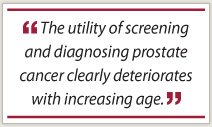Prostate cancer is the most prevalent nonskin cancer in men. An estimated 16% of men are diagnosed with prostate cancer, yet only 3% of men die from it.1 Unlike other cancers, prostate cancer is associated with a prolonged lead-time, meaning it can take anywhere from 5 to 12 years to become apparent. In addition, there are many forms of prostate cancer that are indolent in nature, being present for years without showing any signs of growth or invasion. In fact, autopsy studies have found that up to 70% of 80-year-old men who died of other causes have prostate cancer.2
 Separating men with relatively indolent disease from those with clinically significant disease is the current challenge—a challenge that we are still long strides away from overcoming. Screening for prostate cancer aims to detect cancer early enough that treatment can be initiated, to reduce the mortality associated with prostate cancer. However, with screening comes overdiagnosis, and with overdiagnosis comes overtreatment.
Separating men with relatively indolent disease from those with clinically significant disease is the current challenge—a challenge that we are still long strides away from overcoming. Screening for prostate cancer aims to detect cancer early enough that treatment can be initiated, to reduce the mortality associated with prostate cancer. However, with screening comes overdiagnosis, and with overdiagnosis comes overtreatment.
No Definitive Values
Screening for prostate cancer relies on the measurement of serum prostate-specific antigen (PSA) to predict the chance of malignancy. Results are interpreted in a continuum of risk.1 There is no definitive value that predicts with certainty the risk of cancer. A value of 4 ng/mL is commonly used as a cutoff for recommending biopsy; however, extremely low PSA levels have been noted with aggressive cancers, and benign conditions such as benign prostatic hyperplasia and prostatitis can cause higher PSA levels. In 2005, Thompson et al determined that there is no “safe” PSA value, as the prevalence of prostate cancer associated with a PSA < 0.5 ng/mL is almost 7%, and the associated prevalence is 17% for PSA values between 1.1 and 2 ng/mL.3
Early observational studies were aimed at finding out the role of prostate cancer screening. However, many were not well designed and only fueled the debate, with some studies showing no difference in outcome and others showing a modest benefit.4 Two large randomized trials were organized to try and answer the question of screening for prostate cancer.
Randomized Trials
The Prostate, Lung, Colorectal and Ovarian (PLCO) trial involved over 76,000 men from multiple centers across the United States. These men, aged 55 to 74 years, were randomly assigned to annual PSA blood tests and digital rectal exams, or usual care. After 7 years of follow-up, more cases of cancer were found in the screened group than in the control group, as would be expected. However, the results also showed no benefit and, in fact, possibly some degree of harm in population screening for prostate cancer.
The other large randomized trial was the European Randomized Study of Screening For Prostate Cancer (ERSPC) trial. This study included eight countries and involved the random assignment of over 182,000 men to either screening or usual care. After almost 9 years of follow-up, no significant reduction in prostate cancer mortality was observed between the two groups, but there was a difference in mortality seen in a subset of patients between the ages of 55 and 69. This difference amounted to an absolute reduction of 0.71 prostate cancer deaths per 1,000 men.4
After cancer is diagnosed the majority of men feel compelled to receive treatment, and as already noted, physicians remain unable to determine with any certainty those men who will die from prostate cancer and those who will die with the disease. This inevitably leads to overtreatment, unnecessarily subjecting men to side effects such as incontinence and erectile dysfunction. From the ERSPC trial, we learned that 48 men need to be treated before 1 death from prostate cancer is prevented.4
Conclusions
So what conclusions can we draw regarding prostate cancer screening? The U.S. Preventive Services Task Force recently updated their review of evidence on screening and treatments for prostate cancer, concluding that PSA-based screening “results in small or no reduction in prostate cancer–specific mortality and is associated with harms related to subsequent evaluation and treatments, some of which may be unnecessary.”5
On the other hand, the American Urological Association recommendation is to start screening at age 40 instead of 50, as early PSA levels are more indicative of future prostate cancer occurrence than family history1 and can help establish a baseline PSA level with which to compare.
The utility of screening and diagnosing prostate cancer clearly deteriorates with increasing age. In a population over age 65, approximately 200 men need to be treated for at least 12 years before 1 prostate cancer death is prevented.6 ■
Disclosure: Dr. Crawford is Chairman of the National Prostate Conditions Education Council. Dr. Spendlove reported no potential conflicts of interest.
References
1. Carroll P, Albertsen P, Greene K, et al: Prostate-specific antigen best practice statement: 2009 update. American Urological Association Education and Research, 2009. Available at www.auanet.org. Accessed October 27, 2011.
2. Welch HG, Black WC: Overdiagnosis in cancer. J Natl Cancer Inst 102:605-613, 2010.
3. Thompson IM, Pauler DK, Goodman PJ, et al: Prevalance of prostate cancer among men with a prostate-specific antigen level < or =4.0 ng per milliliter. N Engl J Med 350:2239-2246, 2004.
4. Croswell JM, Kramer BS, Crawford ED: Screening for prostate cancer with PSA testing: Current status and future directions. Oncology (Williston Park) 25:452-460, 2011.
5. Chou R, Croswell JM, Dana T, et al: Screening for prostate cancer: A review of the evidence for the U.S. Preventive Services Task Force. Ann Intern Med. October 7, 2011 (early release online).
6. Wong YN, Mitra N, Gudes G, et al: Survival associated with treatment vs observation of localized prostate cancer in elderly men. JAMA 296:2683-2693, 2006.

